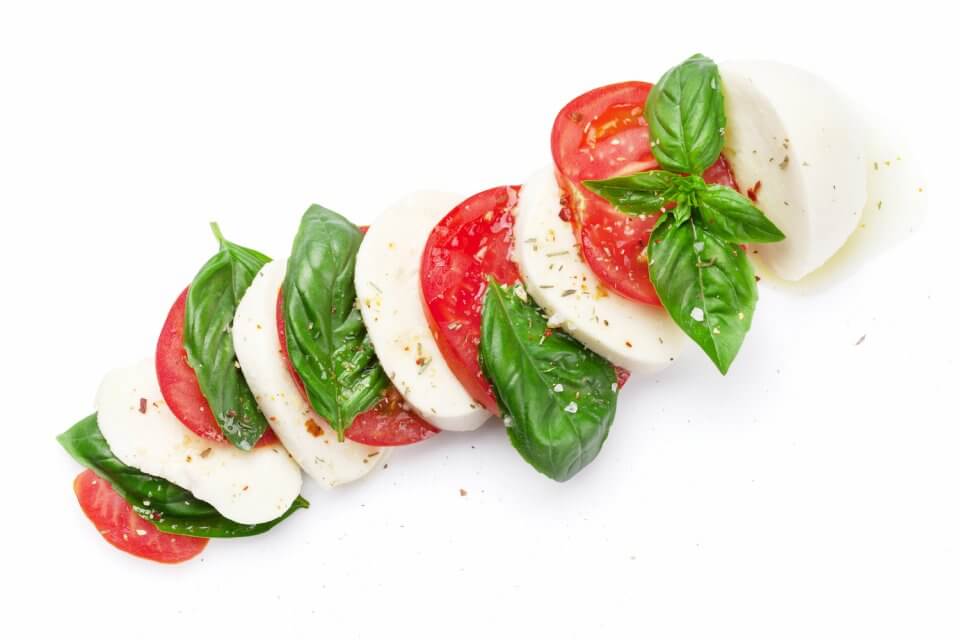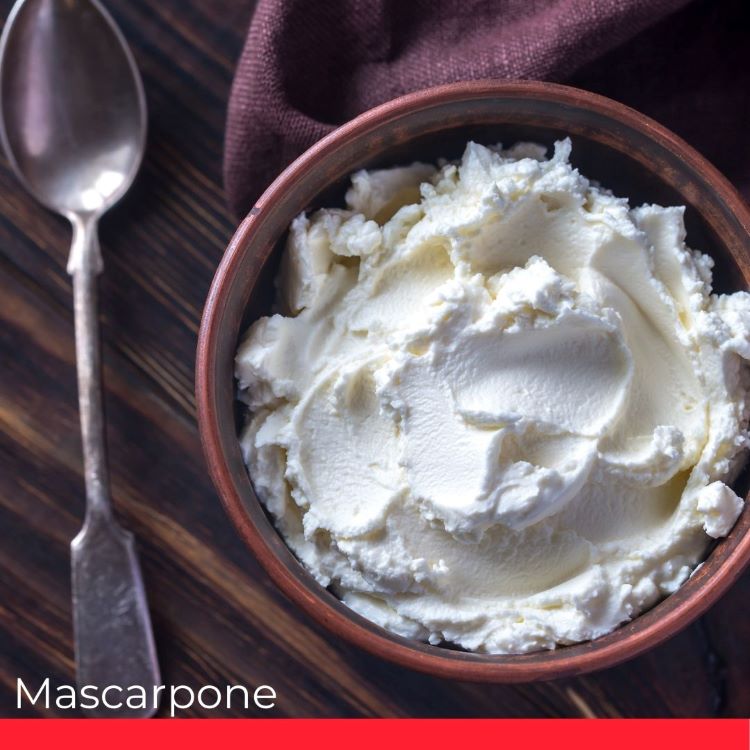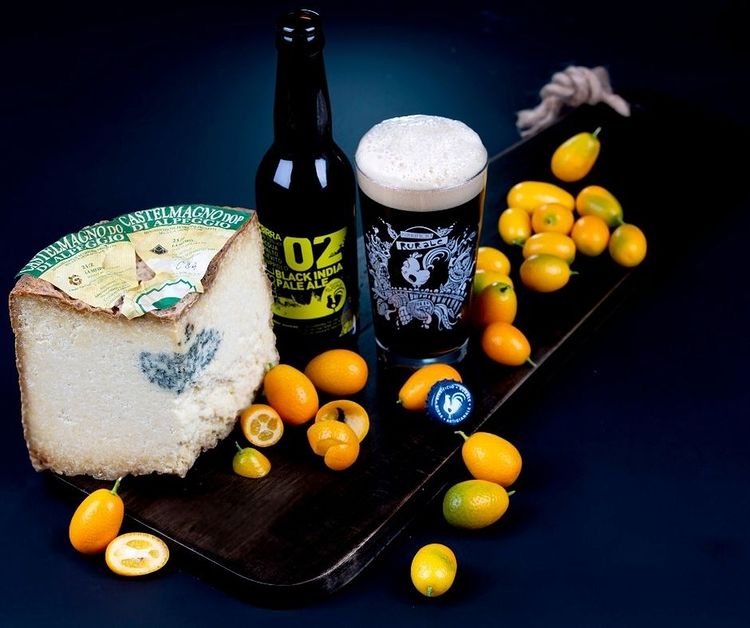Top 22 Most Popular Italian Cheese Types

Excellent as a snack, an appetizer, a main course, or a dessert and matched with a good wine, cheese is the prince of the Italian cuisine. Italian cheese is found in many varieties, all of which need to be tasted in their goodness, region by region, from the North to the South of the country.
Let’s travel to Italy to learn about its gastronomical heritage, discover its history, and hear the regional stories. Welcome to the fantastic and varied world of Italian cheese: a story in evolution between taste and tradition.
Below is a list of some of the most popular Italian cheeses out there.
1. Parmigiano Reggiano (Parmesan Cheese)

Whenever we talk about Emilia-Romagna we instantly think of Parmigiano Reggiano aka the famous Parmesan cheese.
The first testimonies of Parmesan date back to 1254 and it is considered the king of Italian cheeses. Produced in Parma and Modena, Parmesan is hard, semi-fat, produced with unpasteurızed cow’s milk containing no additives, and goes through a slow aging process.
It has a fairly strong smell and aroma and is eaten in flakes or grated on various dishes. Commercially, it can be found in different varieties, characterized by maturations of 12, 24, or 30 months. However it can also be found seasoned for 36, 48, and 72 months.
Check out below a couple of our delicious parmesan-based recipes:
2. Mozzarella

The fruit of an ancient history, dating back to the Middle Ages in southern Italy, Mozzarella’s taste and refinement has conquered the world. The queen of the table, it is among the most exported and loved Italian cheeses.
With a simple and delicate taste, mozzarella is produced with pasteurized cow’s milk to which lactic ferments and rennet are added. White in color, smooth on the outside, typically round in shape, soft and elastic, in order for it to be truly original, you can break it with your hands and it must tear a little whey.
In the kitchen its uses are endless. In addition to being a fundamental topping for pizza, it is eaten in its natural state, dressed with a drizzle of extra virgin olive oil or in a salad with anchovies and basil.
It also accompanies many baked dishes or typical Italian dishes such as melanzane alla parmigiana or mozzarella in carrozza.
Mozzarella can also be made with buffalo milk and it’s know locally as mozzarella di bufala. Buffalo mozzarella is rich, creamy and simply delicious, though it comes with a higher fat content.
Check out below a couple of our mozzarella-based recipes:
3. Fontina

Among its DOP cheeses (i.e. “Denominazione di Origine Protetta”, which means Protected Designation of Origin), the Aosta Valley boasts the famous Fontina.
The history of this famous Italian cheese dates back to the 1200s and its name most probably comes from the family De Funtina, which is frequently mentioned in ancient documents from the Aosta Valley. But there are also other stories that suggest the name comes from the tiny village of Fontinaz, or from the word fontis, referring to how the cheese melts when heated.
Fontina is made with whole cow’s milk from a single milking, which is mixed with water and salt. Once semi-cooked, the cheese becomes soft, elastic, and sweet. The cheese is then matured for 80 days.
It is excellent eaten as it is or melted in a pan, in gnocchi, on steak, or added to soups, stuffings, and salads for extra flavor. Fontina goes very well with a full-bodied red wine.
4. Gorgonzola

Gorgonzola is a DOP cheese which has happily crossed national borders, and is a blue cheese par excellence representing Lombardy.
Originating in the city of Gorgonzola, a 40-minute drive east from Milan, this ancient Italian cheese was first mentioned around the year 1000, though some claim it was made as early as 879 AD. Gorgonzola got its particular characteristics due to the aging technique as it was placed in natural caves where falling spores created mold.
Gorgonzola comes in two varieties. Spicy gorgonzola, made with penicillium roqueforti, has a very persistent flavor and is instantly recognizable from its aroma of porcini mushroom, fermented herbs, and cooked butter.
Sweet gorgonzola, made with penicillium glaucum, is the most common type of gorgonzola and is softer and more delicate in flavor than the spicy gorgonzola. Check out below a couple of our gorgonzola-based recipes:
5. Pecorino Romano

In Lazio you can find the unmistakable Pecorino Romano, one of the oldest Italian cheeses. Pecorino Romano was the staple food for the Roman army and is still produced following the same ancient recipe.
It is a hard, cooked cheese, produced with fresh sheep’s milk, and is characterized by a strong aromatic flavor. It has a cylindrical shape with flat faces and differs from the equally well known Sardinian Pecorino due to its salting and aging period.
Pecorino Romano, not to be confused with American Romano cheese, is super delicious, easy to digest, with a long shelf life, and can be enjoyed on its own or with broad beans, fruit and honey, but above all, with traditional Roman first courses such as spaghetti alla carbonara or cacio e pepe.
6. Provolone

Campania is famous for mozzarella di bufala (i.e. buffalo mozzarella), but it is also famous for Provolone del Monaco DOP. Its name comes from the cloaks worn by those transporting it from mountain dairies to the markets of Naples, their cloaks sheltering them from the chilly night winds blown from the sea.
Provolone is a semi-hard cheese made from cow’s milk. It is an elastic and compact cream-colored cheese with yellow shades and a semi-oval and elongated shape. At medium maturity, Provolone is sweet and buttery. As it ages, Provolone becomes spicier and has a strong flavor, but is always very tasty.
7. Burrata

Apulia is known as the region of Burrata, one of the two IGP cheeses of Italy. IGP stands for Protected Geographic Origin, which means that at least one of the stages of production, processing or preparation must take place in the area of designation.
Burrata is an Italian cheese produced with cow’s milk and obtained from a fusion of cream and mozzarella strips.
According to various sources, it was invented by local cheesemaker Lorenzo Bianchino Chieppa from Andria in the 1920s. Legend has it that in the 1920s, due to heavy snowfall preventing milk from being brought into the city, Bianchino was forced to transform the milk into cream and later evolved into the creamy cheese that burrata is today.
This is why Burrata has the taste of fresh cream and butter. It is very sweet, pleasant and has no salt. It is a simple cheese, fresh and has an irresistible taste.
8. Mascarpone

If you love Italian desserts, then you’re definitely a big fan of mascarpone. It is a soft Italian cheese originally produced in Lombardy. Its name comes from the word “mascherpa”, which refers to the cream of milk.
However, another theory is that the word comes from an expression used by a Spanish nobleman who, in the thirteenth century, was so ecstatic about the taste of mascarpone, he exclaimed it is “mas que bueno“, which translates to “more than good“.
Mascarpone is a creamy and dense cheese, resulting from the process of acidifying cream. Its color varies from snow white to light yellow and it has a sweet and buttery taste.
It is an excellent base for many desserts, including the very well-known Tiramisù.
9. Puzzone of Moena

This cheese is a symbol of Trentino and is famous for its characteristic strong and intense smell, which is improperly called stinky (puzzone).
Puzzone di Moena DOP is a whole unpasteurized cow’s milk cheese of which there are three types: traditional, aged, and malga, the latter being the most prized one.
Provolone is a delicate and elastic cheese with a flavor of fermented herbs. It is so distinctive that it deserves to be eaten on its own, in a sandwich or perhaps with a glass of red wine.
Provolone can also be enjoyed in the typical dishes of the region such as polenta or gnocchi, or melted on toast.
10. Asiago

In the Asiago Plateau, between the provinces of Veneto and Trentino, cheese has been produced since the year 1000. There was only sheep farming back then, with cattle farming being introduced in the 15-16 century. But bovine milk was used for cheesemaking only starting the 19th century so Asiago cheese, in its current form, is a rather young cheese by Italian standards.
Extremely green pastures, fresh and healthy air, pure water, and a mild climate: these fundamental elements allow the local cows to produce a unique milk which is used to create asiago cheese.
Asiago is a semi-cooked cow’s milk cheese that can be consumed either fresh or aged and has a sweet and soft taste. It is eaten alone or accompanied by a slice of warm bread and a glass of white or red wine. It can also be added to risottos and polenta, melted with sausage, or grated on pasta.
11. Montasio

This is typical of Friuli-Venezia Giulia and of a part of Veneto, and has a rich flavor that brings together all the history and traditions of the pastures of the Alps.
Production of Montasio is ancient, going back as far as the 13 century. The Benedictine monks of the valleys of the Carnic and Julian Alps produced the cheese to preserve milk and help reduce food shortages during long, harsh winters.
In time, they refined their techniques and the cheese, made only from locally produced cow’s milk, acquired a unique and rich taste.
It is a cylindrical-shaped cheese that can be aged in different ways. In the kitchen, it is perfect grated on pasta dishes or asparagus, used for the typical Friulian dish frico, in risottos, in desserts, or combined with dried fruit or pears.
Montasio cheese goes well with dry and aromatic wines.
12. Castelmagno

This is a very old Italian cheese from the province of Cuneo in Piedmont. It has a semi-hard texture, is pretty high in fat, and is slightly blue-veined.
Nutritious and tasty, Castelmagno is produced with whole or partially skimmed unpasteurized milk, mainly cow’s but with a percentage of sheep’s and/or goat’s milk of medium aging.
Castelmagno has a fine, delicate flavor when fresh, becoming savory and spicy as it ripens
Castelmagno has a cylindrical shape with flat sides. The cheese is white and the rind is thin and yellow when young; as it ages, it becomes thicker, wrinkled, and darker in color. Castelmagno has a fine, delicate flavor when fresh, becoming savory and spicy as it ripens.
It is excellent eaten on its own, spread on toast as an appetizer or aperitif, combined with vegetables, added to soufflés, or for seasoning gnocchi, risottos, tortelloni, and savory pies.
It goes perfectly with a full-bodied red wine, preferably Piedmontese.
13. Bitto

Bitto originated in the Orobic Valleys and the alpine pastures and it’s the result of some very favorable geographical circumstances like humidity and temperature, but also the dexterity of local cheesemakers. The production area of Bitto DOP includes the province of Sondrio and municipalities of the upper Val Brembana in Lombardy.
Bitto is produced in the summer in 12 authorized mountain pastures, from whole unpasteurızed cow’s milk from Bruno Alpina cows. It has a flavor rich in herbaceous aromas and its flavor improves with time. A type of Bitto cheese can be preserved for over 10 years. Its name derives from the Celtic word bitu, which meant perennial.
It is recommended you taste it on its own, accompanied by a glass of still, full-bodied red wine.
14. Taleggio

Originally from the Taleggio Valley, from which it takes its name, between Lecco and Bergamo in Lombardy, Taleggio is a square, semi-soft cheese made of cow’s milk and has a soft crust and a sweet, slightly aromatic taste.
Taleggio cheese has been produced since the High Middle Ages, when it was important to preserve excess milk and was stored in the valley’s caves.
Taleggio melts perfectly, making it suitable for first courses, risottos in particular. It goes very well with pumpkin, radicchio, and mushrooms and is excellent in quiches, flans, and pies. It goes well with polenta and baked pasta dishes and it is perfect for fondue. It is also delicious on its own.
15. Squacquerone

Squacquerone is a fresh, creamy cheese made of pasteurized whole cow’s milk. It is native to Romagna. This excellent cheese is similar to the more common stracchino, which has become well known and loved because it is a fundamental ingredient of a local delicacy: piadina.
White in color, easy to spread, it has rural medieval origins. It is produced all year round; however, only in a few authorized dairies. Its unique and delicate taste expresses all the essence of the region to which it belongs.
Squacquerone derives from the Romagnolo dialect squacquerare (meaning to melt), evidently chosen due to its soft and creamy consistency.
16. Raviggiolo

Typical of the Apennines of Tuscany and Emilia Romagna, Raviggiolo is a soft fresh cheese produced with whole cow’s milk. It has a history of almost five hundred years and over that time, it has become an integral part of local culinary traditions.
It comes in a small and circular shape. As it is fresh, it is perishes quickly and should only be kept for 3-4 days in the refrigerator. Soft and consistent, it is excellent eaten alone or matched with fresh pasta, savory cakes, or desserts, and maybe with a good still white wine.
17. Formaggio di Fossa

Should you visit the Marches region, you have to taste the Formaggio di Fossa di Sogliano DOP, though it is, in reality, shared with Emilia Romagna.
Pits here were used to store food and then to protect the cheese from sieges and epidemics. The peculiar characteristic that makes it famous is therefore the environment in which the maturation process takes place.
Its color varies from white to straw yellow, its taste is initially delicate and sweet and then becomes more spicy and bitter.
Formaggio di Fossa is a passepartout in the kitchen: perfect for many recipes, from appetizers to desserts.
18. Caciocavallo

In Molise there is Caciocavallo, which orıgınated at the time of Magna Graecia but is now found throughout the South of Italy. It is a fat cheese, non-skimmed, with different maturations: young, medium, or aged. It has a pear shape with a small head, and hangs from a beam to dry (hence the name).
It is sweet and quite aromatic, and is very eclectic in the kitchen. Raw or cooked, it can be used in any recipe, even those that are very quick. It can be grilled, sliced for salads, combined with vegetables or pan-fried.
19. Canestrato

The DOP cheese of excellence in Apulia is the Canestrato. It is mainly produced in the provinces of Foggia and Bari, in places ranging from 250 to 700 meters above sea level.
This full fat cheese made with sheep’s milk is a hard cheese of medium or long aging. It has a homogeneous surface but is crossed with streaks left by the rush baskets used to produce it. This technique is also mentioned in the Odyssey when Ulysses meets the giant Polyphemus.
Eclectic in the kitchen, it can be eaten alone or grated over fruit, vegetables, grilled meat, pasta with meat sauce or soups. And, depending on the seasoning, it goes well with more or less full-bodied white wines.
20. Scamorza

Originating in the South of Italy (especially Abruzzo, Molise, Basilicata and Campania), scamorza is a very short seasoning cheese usually prepared with a mix of cow’s and goat’s milk, but some varieties are produced solely with cow’s milk.
The name scamorza refers to the work of the dairyworkers who will scamozza (remove) the curd with their hands to give it the characteristic pear shape, with the head choked by a thread of straw.
It is a spun and semi-hard white cheese, dense but elastic at the same time. It can be found fresh with a thin, straw-yellow rind or smoked, brown in color and more compact.
It has a very delicate taste and is excellent for enriching salads, in baked preparations, or sliced and grilled, ideal for filling a large number of dishes, especially the recipes of the national tradition and in particular those of the South.
21. Fiore Sardo

In Sardinia there is Fiore Sardo DOP, a very ancient cheese dating back to the Nuragic period, and is the main cheese of the region. The name derives from pischeddas, the perforated molds made of chestnut wood, used to give it the shape, on the bottom of which was carved a flower.
It is the only DOP sheep’s cheese in which the milk is purely and exclusively unpasteurized. It has a thin, dark-colored crust, while the cheese varies between white and straw yellow.
It is grainy, with a very intense and slightly spicy flavor; it is very digestible and can also be smoked.
22. Grana Padano

Grana Padano is an Italian cheese very similar to parmesan and made from unpasteurized cow’s milk. It has a long tradition and it’s one of the best selling traditional Italian cheeses.
Grana Padano is made with much less strict grading policies than Parmesan, meaning it is more readily available and often less expensive.
Grana Padano is mild in flavor, but that doesn’t stop it from having an intense odor. Grana grates easily and it has a crumbly texture, but it can turn into melting goodness, forming a fatty, rich crust.
Notable Mention – Ricotta
Ricotta is often labeled as cheese outside Italy, but Ricotta is technically not a cheese, but a dairy by-product. It is made from whey —that is, the watery liquid that remains after cow, sheep or goat cheese is made.
Related: Most Popular Italian Sausages & Cured Meats

Related: Most Popular Italian Snacks


